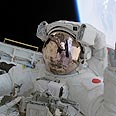
Sharing space in space
Way we monitor space reflects changes in society, writes Ray Hanania
When I was a kid, the first spacecraft fired off into space back in the 1960s inspired a national excitement of a brave new world.
Today, the launching of the shuttle has become more frightening and filled with fears as we only pay attention to the dark side and potential threats.
Have we come full circle?
The push to explore outer space began as a frightening experience, driven by fears that the Russians had placed a secret vessel into space called “Sputnik” back in the late 1950s.
Sputnik produced a whole breed of television science fiction fears as much about alien invasions as about insects mutated from tiny creatures to the size of skyscrapers.
Combined with what we knew about the power of the atomic bomb (dropped 60 years ago on Japan to end the Pacific battles of World War II), outer space was truly scary.
In school, our teachers would practice atomic bomb drills in which we were rushed out of our classrooms, and lined up squatting in the narrow hallway of the building with our hands wrapped around our heads, in fetal positions.
Teachers would yell at kids that would lift their heads and look around at the odd scenario, warning, “Do you want to burn up? Keep your head down.”
As we got older, in 2nd and 3rd grade, we were allowed to remain in our classrooms to hide under our desks.
US catches up
Years later, we realized the entire exercise was futile. In an atomic bomb blast that would come from some super secret Russian Spy satellite in space, we would all disintegrate into glowing radioactive ashes.
So it was with relief in February 1962 that the United States got the upper hand in space, sending the first astronaut around the world three times in a tiny Mercury capsule called “Friendship 7.”
A few months later, Scott Carpenter followed in “Aurora 7,” circling the globe three times also. The symbolism of “7” is not a coincidence. It is considered by Americans to be the luckiest possible number.
Circling the globe only three times was enough as most people were used to flipping a coin three times to prove that events were pre-ordained and more than luck.
Not only did the Glenn and Carpenter events make Americans feel secure – they beat the Russians and learned that the Sputnik was just a “satellite” to transmit information – but it also sparked a national enthusiasm that washed out our fears.
The whole nation breathed sighs of relief and joy and did a little bit more, too.
The U.S. government agency monitoring births reported that “Glenn” and “Scott” had become the two most popular names of new born boys. I remember at least five families in our neighborhood had given their baby boys the names “Glenn” and “Scott.”
Fear replaces hope
But things changed. Not quickly but over a period of time.
We watched the first astronaut die, a Russian, in 1967 when a spaceship crashed. We cried when a capsule preparing for flight exploded in fire killing three astronauts on Apollo 1 on January 27, 1967, and we were raised to new heights when the first man – an American – walked on the surface of the moon on June 20, 1969.
Like everything in life, the space missions became commonplace and mundane. Success and tragedy were no longer surprises. Astronauts were not just walking on the moon, they were even hitting golf balls.
The futility of hiding anywhere in a nuclear holocaust was swept away with reason that the best defense was to convince the rest of the world not to use atomic bombs at all. Space was intended for the expansion of mankind, not its demise, we were told.
And just when many Americans and the world turned away from the routine space launches, disaster struck. The unbelievable occurred in January 28, 1986 when the space shuttle Challenger exploded before our very eyes.
It was a date that burned in our memories as powerfully as the assassination of President John F. Kennedy and the car crash that later killed Princess Diana.
Suddenly, we began paying attention to the space voyages, not so much to feed our pride but to quench the thirst of human nature for the frightening and the macabre.
As the space shuttles slowly restored confidence they could succeed again, public attention again dissipated. Until tragedy struck again a few years ago when the Columbia Shuttle burned up during re-entry on Feb. 1, 2003.
Today, the public’s attention has returned to space launches, in part fearing that more disasters will take place.
Binational exploration?
For Arabs and Israelis, they do share something. Both peoples lost heroes in the two shuttle disasters. Arabs lost Christa McAullife, a teacher of Lebanese heritage who died in the Challenger explosion. And Israelis lost scientist Ilan Ramon, who died in the Columbia disaster.
This week, we all shared a collective sigh as the Shuttle Discovery overcomes potential disaster.
But wouldn’t it be nice if the next shuttle were to include an Israeli and Palestinian astronauts on the same mission, reinforcing the hope for peace and becoming truly a giant leap for mankind?










